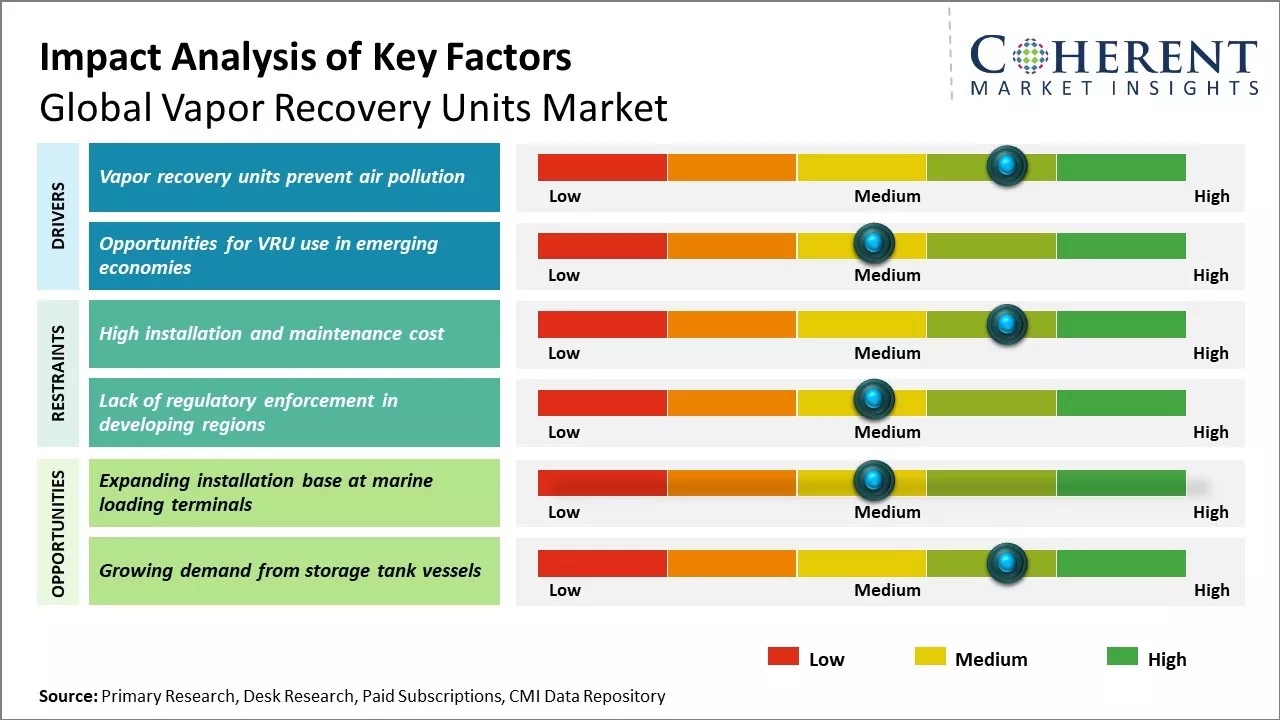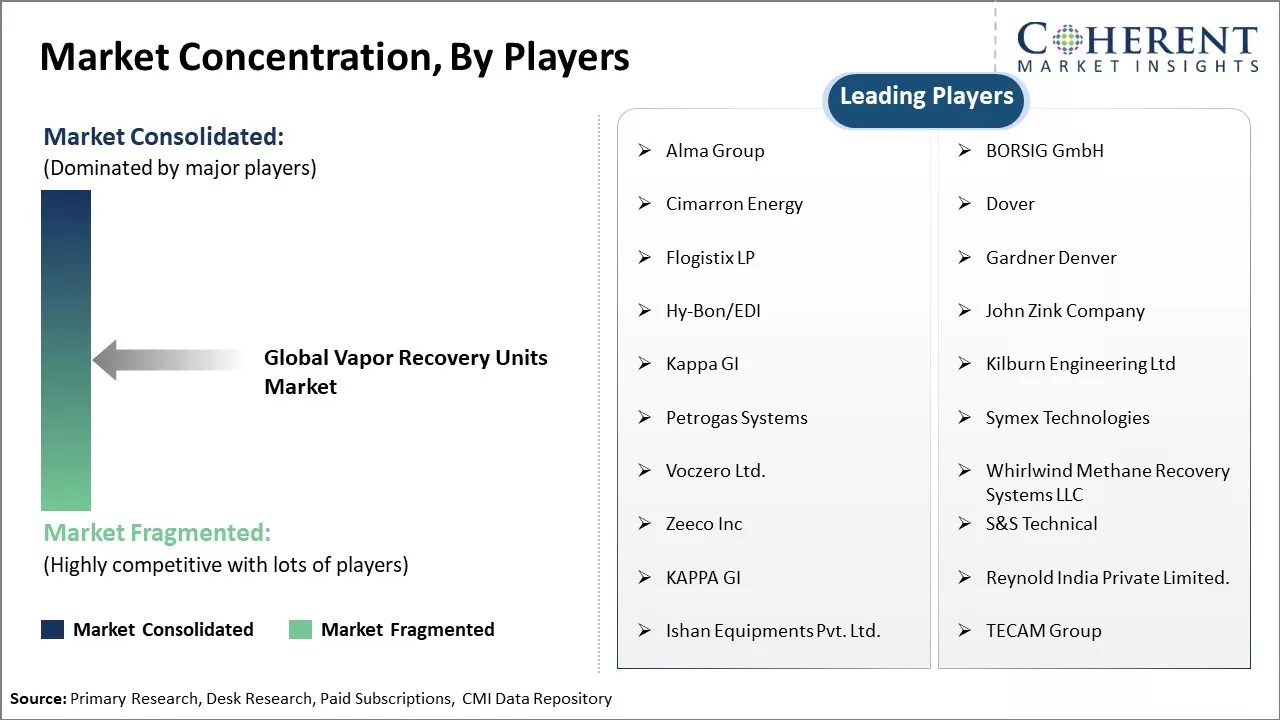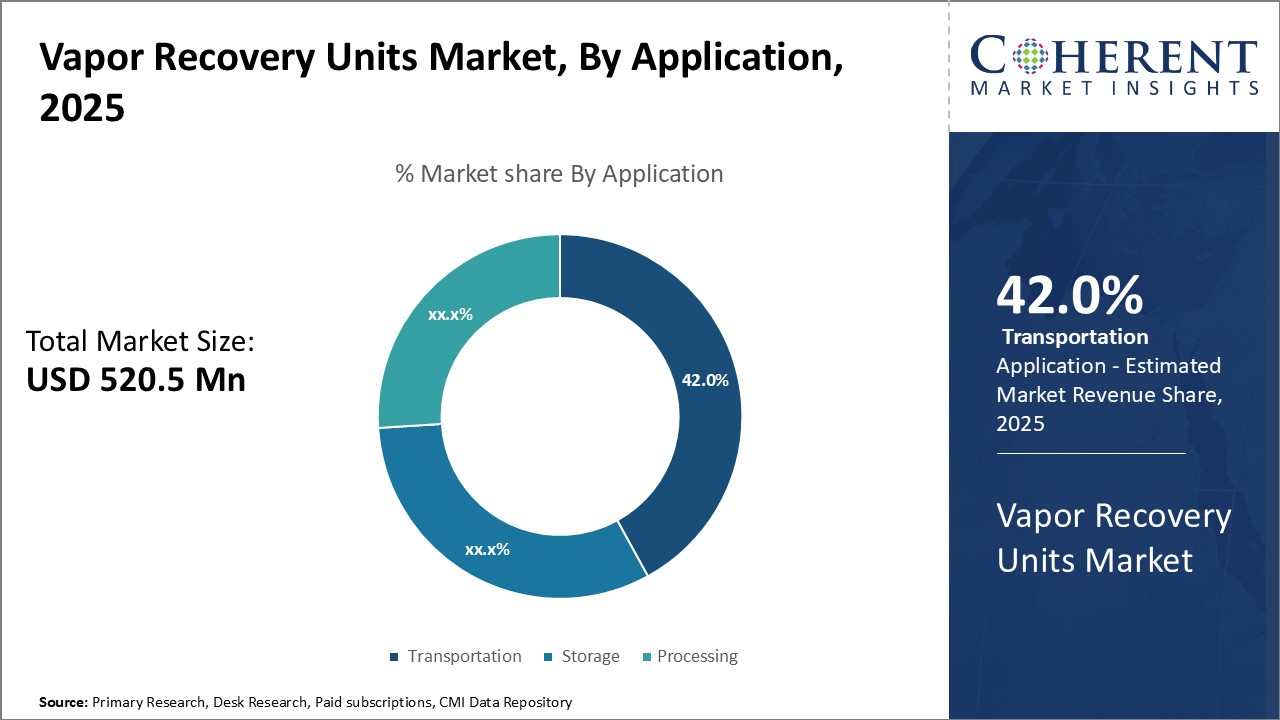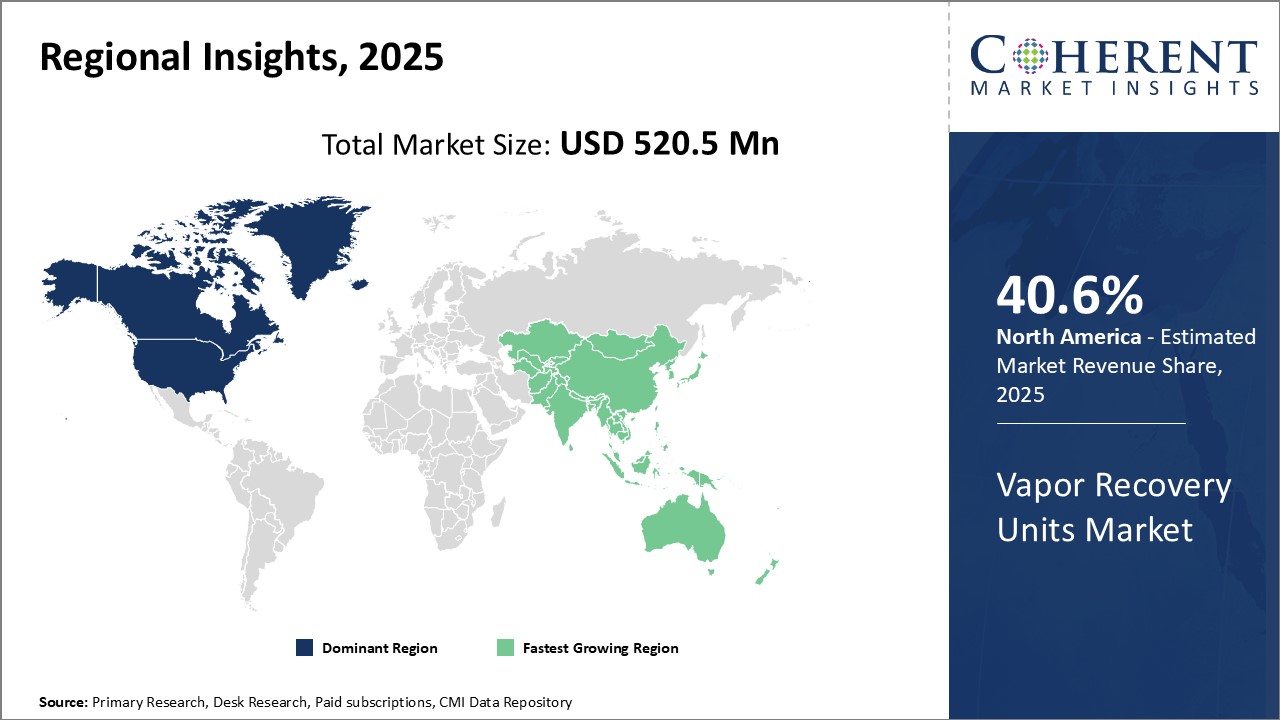The vapor recovery units market is estimated to be valued at USD 520.5 Mn in 2025 and is expected to reach USD 640.6 Mn by 2032, exhibiting a compound annual growth rate (CAGR) of 3.0% from 2025 to 2032.

Discover market dynamics shaping the industry: Download Free Sample
The vapor recovery units market is expected to witness significant growth over the forecast period. Stringent environmental regulations regarding volatile organic compound (VOC) emissions from storage tanks and truck loading racks at petroleum terminals are expected to drive the demand for vapor recovery units. Additionally, growing concerns regarding hazardous air pollutants (HAPs) and greenhouse gas emissions from the oil and gas industry are also anticipated to boost the market growth. Rapid industrialization and urbanization in developing nations have led to a rising demand for petroleum products, which, in turn, is expected to increase installations of vapor recovery units across oil marketing companies and petroleum product manufacturers over the next few years.
Vapor recovery units prevent air pollution
As environmental regulations across the world have become more stringent in recent years, preventing air pollution from volatile organic compounds (VOCs) has become a high priority. Vapor recovery units (VRUs) play a critical role in capturing hydrocarbon vapors that would otherwise escape into the atmosphere during the loading and unloading of gasoline and other petroleum products. These vapors contain various harmful VOCs like benzene, toluene, and xylene that can negatively impact both public health and the environment if released unchecked. The strict enforcement of emission standards by environmental agencies has led petroleum product terminals, gas stations, and other transfer stations to increasingly rely on VRUs. Various innovations in VRU design like improved vapor collection efficiency and onboard monitoring systems have also made them more effective at capturing vapors. With air quality emerging as a major public concern, regulations around VOC emissions are expected to become more comprehensive over time. This growing regulatory pressure will be a key driver sustaining the long-term demand for VRUs across many industries involved in the distribution of petroleum and chemical products.

Get actionable strategies to beat competition: Download Free Sample
Opportunities for VRU use in emerging economies
While developed markets in North America and Europe have established regulatory frameworks around vapor recovery for some time now, many developing economies are still in the initial stages of addressing air pollution from their rapidly growing energy and transportation sectors. As urbanization and industrialization progresses in countries like India, Indonesia, and across Africa and Latin America, VRU technology presents an opportunity to curb emissions from an early stage itself. These emerging economies represent huge potential for VRU vendors to establish local manufacturing and service networks to tap into infrastructure projects across areas like oil terminals, LNG import facilities, pipelines, and gasoline retail. Several of these countries have also started introducing their own emissions standards modeled on international protocols. This regulatory push when combined with a need to manage VOC emissions from intensive industrial growth could spur sizable VRU deployment projects across various nodes in their developing fuel distribution infrastructure. Vendors successful in localizing their value chains and customizing solutions for these new markets stand to gain considerable long-term business as emission control becomes a rising priority.
Key Takeaways from Analyst:
The vapor recovery units market is expected to witness steady growth over the next five years driven by stringent government regulations regarding VOC emissions. Many regions and countries are implementing new norms to reduce air pollution from petroleum and chemical industries which use Vapor Recovery Units (VRUs) in their facilities
High initial investment requirements can negatively impact small scale adoption across developing Asian and Latin American nations. Lack of strict monitoring of VOC emission standards implementation in these regions poses a challenge for rapid market expansion. Alternatives like incineration and carbon absorption are also gaining traction which needs to be addressed.
New product development around condensate recovery, efficiency improvement, remote monitoring and data analytics will provide key growth opportunities for established as well as new players. Collaboration with end-use industries and focusing on total cost of ownership over the lifecycle can help vendors boost sales in price-sensitive developing markets. Entering into long-term service and maintenance contracts is another strategy to tackle budget constraints. Overall, the vapor recovery units market seems poised to witness stable growth supported by an improving regulatory push globally in the coming years.
Market Challenges: High installation and maintenance cost
The high installation and maintenance cost associated with vapor recovery units (VRUs) has been a major restraint on the growth of the global VRU market. VRU systems require substantial capital expenditure for installation due to the infrastructure needed to capture vapors and route them through pipes and treatment systems. The installation process itself is also time-consuming and labor-intensive.
Market Opportunities: Expanding installation base at marine loading terminals
Expanding installation base at marine loading terminals presents a major opportunity for the global vapor recovery units market. As international seaborne trade of liquid petroleum gases and other volatile organic compounds continues to rise in the coming years, requirements to curb hazardous emissions during marine transport will become increasingly stringent. Additionally, Rising volumes of chemicals, petrochemicals and petroleum products being shipped between countries will mean higher throughput at key ports and marine terminals. This will motivate terminal operators and national authorities to aggressively reduce emission of VOCs and hazardous air pollutants from vessel loading/unloading manifolds into the atmosphere. Vapor recovery units that collect and process Displaced vapor back into the liquid phase during marine loading/unloading emerge as an effective solution. Major global initiatives like the International Convention for the Prevention of Pollution from Ships also mandate the use of vapor control systems at marine terminals to curb ocean pollution.

Discover high revenue pocket segments and roadmap to it: Download Free Sample
Insights by Application: In terms of application, transportation contributes the highest share of the market owing to increased demand for oil and gas transportation
The transportation segment is expected to account for 42.0% share of the vapor recovery units market by application in 2025. This is mainly attributed to the rise in the transportation of oil and gas across the world. As oil and gas exploration activities are increasing globally, the need to transport hydrocarbons from production sites to refineries or storage hubs is also growing. Vapor recovery units play a crucial role in mitigating VOC emissions during hydrocarbon transportation through marine vessels, railcars, and tank trucks. With the increasing volumes of crude oil, refined petroleum products, and natural gas being traded worldwide, transportation becomes a major source of fugitive emissions. Stringent environmental regulations targeting reductions in VOC emissions are compelling transport operators to adopt vapor recovery solutions. Furthermore, advancements in vapor recovery technologies have enhanced their applicability in diverse transportation modes. Mobile vapor recovery units designed for road tankers and marine bunkering are witnessing higher demand. Such factors are propelling the growth of the transportation segment in the global vapor recovery units market.
Insights by End-use Industry: In terms of end-use industry, oil & gas contributes the highest share of the market driven by the need to curb emissions from production and processing
The oil and gas segment is expected to account for 44.8% share in the vapor recovery units end-use segment in 2025. This is mainly due to the stringent emission control mandates for the industry. As oil and gas production and processing activities are major sources of volatile organic compound (VOC) emissions, regulators worldwide are imposing strict guidelines to curb such emissions. Since vapor recovery units are effective in capturing hydrocarbon vapors released during petroleum production, processing, storage, and transfer operations, their demand is increasing from oil refineries, natural gas processing plants, oil and gas storage terminals, and other facilities. Furthermore, advancements in vapor recovery technologies have enhanced their suitability for diverse applications across the upstream, midstream, and downstream sectors of the oil and gas industry. Rising investments in oil and gas infrastructure also prompt the growth of vapor recovery units installations. Such factors cumulatively support the dominance of the oil and gas industry in the vapor recovery units end-use industry segment.

Need a Different Region or Segment? Download Free Sample
North America remains the dominant regional market for vapor recovery units. The region is expected to account for 40.6% of the market share in 2025. With the U.S. being the single largest consumer market for gasoline and natural gas, vapor emission control regulations have been stringent for many years. Many of the major manufacturers have prominent operations positioned to best serve the North American customer base. With a well-established oil and gas sector throughout the region, there is widespread application of vapor recovery units across the supply chain from production and transportation to retail fueling stations.
Asia Pacific has emerged as the fastest growing regional market for vapor recovery units in recent years. Rapid industrialization and economic growth across developing nations like China and India have led to a surge in the energy demand. As these countries look to expand their oil and gas infrastructure to meet rising consumption, government mandates on environmental protection are being enforced. This includes requirements for vapor control at industrial loading and offloading points as well as gasoline dispensing facilities. Given the size of Asia Pacific’s economies and projections for continued gains in energy usage, vapor recovery solutions are finding expanding opportunities.
Vapor Recovery Units Market Report Coverage
| Report Coverage | Details | ||
|---|---|---|---|
| Base Year: | 2024 | Market Size in 2025: | USD 520.5 Mn |
| Historical Data for: | 2020 To 2024 | Forecast Period: | 2025 To 2032 |
| Forecast Period 2025 to 2032 CAGR: | 3.0% | 2032 Value Projection: | USD 640.6 Mn |
| Geographies covered: |
|
||
| Segments covered: |
|
||
| Companies covered: |
Alma Group, BORSIG GmbH, Cimarron Energy, Dover, Flogistix LP, Gardner Denver, Hy-Bon/EDI, John Zink Company, Kappa GI, Kilburn Engineering Ltd, Petrogas Systems, Symex Technologies, Voczero Ltd., Whirlwind Methane Recovery Systems LLC, Zeeco Inc, S&S Technical, KAPPA GI, Reynold India Private Limited., Ishan Equipments Pvt. Ltd., and TECAM Group |
||
| Growth Drivers: |
|
||
| Restraints & Challenges: |
|
||
Uncover macros and micros vetted on 75+ parameters: Get instant access to report
*Definition: Vapor recovery units market is the market for vapor recovery units - equipment that captures hydrocarbon vapors that would otherwise emit into the atmosphere during the transfer and storage of volatile petroleum liquids such as gasoline. Vapor recovery units collect vapors during refueling of vehicles at gas stations as well as during the loading and unloading of gasoline tank trucks. They help reduce air pollution by limiting atmospheric emissions of gasoline vapors which contain volatile organic compounds and toxic pollutants.
Share
Share
About Author
Yash Doshi is a Senior Management Consultant. He has 12+ years of experience in conducting research and handling consulting projects across verticals in APAC, EMEA, and the Americas.
He brings strong acumen in helping chemical companies navigate complex challenges and identify growth opportunities. He has deep expertise across the chemicals value chain, including commodity, specialty and fine chemicals, plastics and polymers, and petrochemicals. Yash is a sought-after speaker at industry conferences and contributes to various publications on topics related commodity, specialty and fine chemicals, plastics and polymers, and petrochemicals.
Missing comfort of reading report in your local language? Find your preferred language :
Transform your Strategy with Exclusive Trending Reports :
Frequently Asked Questions
Joining thousands of companies around the world committed to making the Excellent Business Solutions.
View All Our Clients